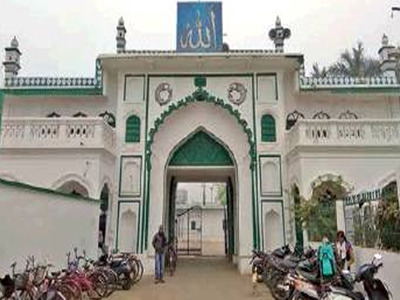Gorakhpur, UTTAR PRADESH :

Not many might know that Gorakhpur, the epicentre of the Nath sect, is home to a two-century-old Imambara as well. Built with the help of Nawab Asaf-ud-Daulah, the Imambara has been included in the list of places being promoted by UP Tourism.
Legend goes that once when the Nawab was out hunting in a forest in Gorakhpur, he came across a man meditating by the side of a dhuni (slow burning fire) deep in the woods.
Seeing the mystic wearing almost no clothes, the Nawab offered his expensive shawl to him as it was a bonechilling winter evening.
However, not welcoming of the move, the man, identified as mystic Hazrat Roshan Shah, threw it over the dhuni. But, instead of burning to ashes, the shawl did not catch fire at all, leaving the Nawab bewildered. Seeing his expressions, the mystic replied that the shawl was kept in the safest of places and he could reproduce it on demand. Then, the man took the unscathed shawl out from his ‘dhuni’ and offered it back to the Nawab.
Amazed at his spiritual powers, the Nawab offered him a handsome grant but Shah refused. When the Nawab insisted, Shah asked him to get an Imambara built for Imam Hussain and give some land for the Imambara’s waqf.
As ordered, Asaf-ud-Daulah granted 17 villages in Daud Chak area cash and promised to send gold and silver tazias to the saint. In a book titled Shahernama Gorakhpur, an article by Afganullah Khan notes that the land for the Imambara was handed over to Shah in 1796 and construction began soon after.
The saint died in 1805 and was succeeded by his nephew Ahmed Ali Shah, popularly known as Miyan Sahab. The Imambara came to be known as Miyan Sahab Ka Imambara. It is this name that has been included in the list of places being promoted by the Uttar Pradesh government to bring Gorakhpur on the national tourist map.
It found a mention in the ‘list of places of interest for tourism’ at Gorakhpur Mahotsava too. The government also plans to invite proposals from corporates for investment at tourist sites—including this Imambara.
With its impeccably white exterior, the grandeur of the Imambara can be seen only during the first 10 days of Muharram when azadari rituals are performed. “At least 1 lakh devotees visit the Imambara during Muharram,” says Nahid Shama, principal of a girls’ PG college run by the Imambara Trust.
Blogger Mazhar Naqvi has noted that the traditions of azadari came to the Imambara from Awadh. “Nawab Asaf-ud-Daula sent gold- and silver-plated tazias for the Imambara here from Lucknow. It is believed that the saint had promised to conduct azadari on behalf of the Nawab, and he kept his word,” Naqvi has noted in his article ‘Roshan Ali Shah and the Imambara of Gorakhpur’.
Local writer Prem Paraya stated that the estate grew manifold under the leadership of Roshan’s successors who took keen interest in administrative affairs of the Imambara and related property. “It is said that by then, the estate’s exchequer had lakhs in cash, many gold and silver blocks and a treasure of ‘asharfis’. The waqf was so wealthy that it gave a loan to the East India Company as well,” says Paraya.
source: http://www.timesofindia.indiatimes.com / The Times of India / Home> News> City News> Lucknow News / by Shailvee Sharda / TNN / April 01st, 2018








